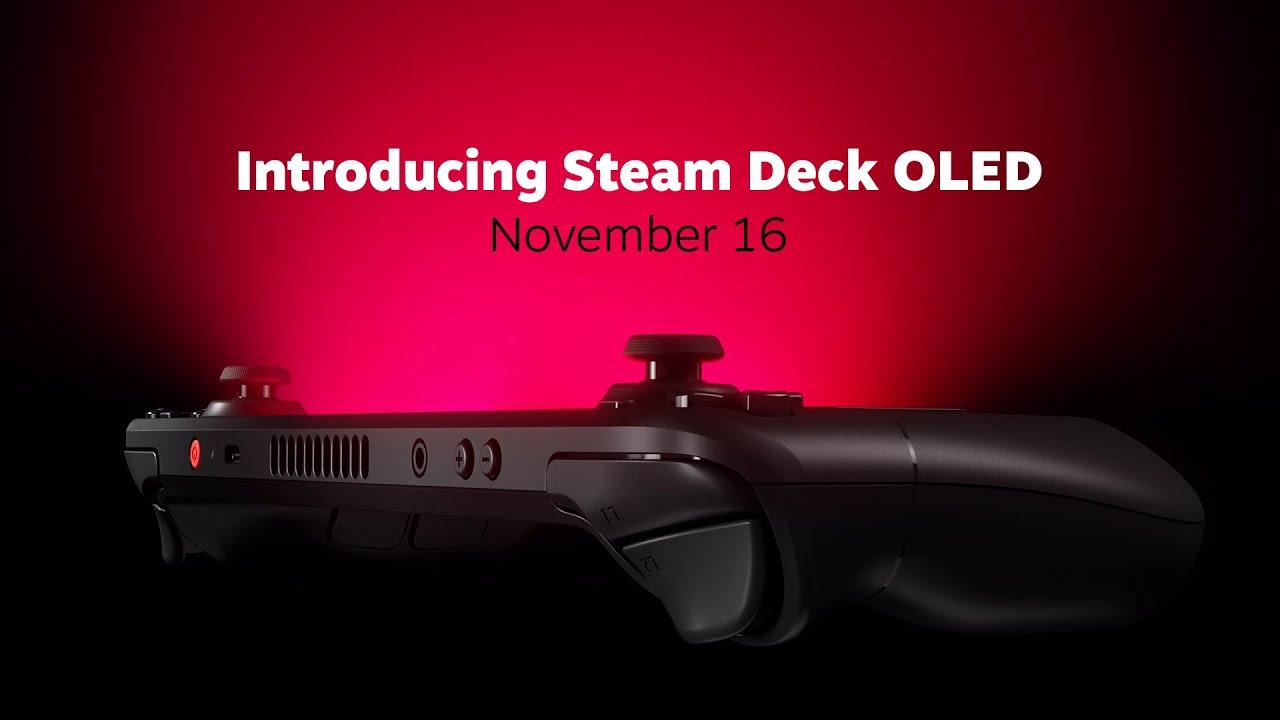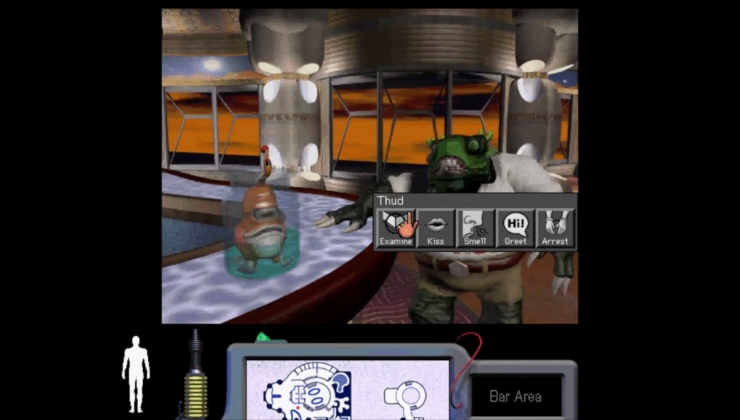Valve has today announced the brand new Steam Deck OLED model with some great sounding upgrades inside so here's the details.
This is the same basics as the original Steam Deck models but comes with an HDR OLED screen, a longer lasting 50Whr battery, faster WiFi, and a slew of tweaks and improvements across the board. Valve say the HDR OLED was "designed from the ground up for gaming", gives you "30-50% longer battery life", has WiFi 6E and gives improved thermals with a bigger fan while being 5% lighter than the original models. Oh, the OLED screen is also bigger at 7.4" (from 7.0") and goes up to 90Hz!
It will also come with a brand new carrying case for the 1TB models that has a removable liner, better touch-screen, easier repairs with Torx type screws that go into metal threads, so no messing up the structural integrity and Valve say the internal components are "now easier to access, and Steam Deck OLED replacement parts will be coming to iFixit soon". Even the APU was upgraded to 6nm for better efficiency, and the memory was updated to 6400 MT/s, improving latency and power management.
Not just that, you're also getting lower-priced models with the original LCD screen.
- Steam Deck 256GB LCD: Now $399 / £349 (effective immediately)
- Steam Deck 512GB OLED: $549 / £479
- Steam Deck 1TB OLED: $649 / £569
- Steam Deck 1TB OLED Limited Edition (translucent colorway): $679 (US/Canada only)
Steam Deck OLED will be available November 16th at 10 AM Pacific / 6PM UTC in USA, Canada, United Kingdom, and European Union, as well as Japan, South Korea, Taiwan, and Hong Kong via KOMODO.
However, the 64GB and 512GB LCD models are now being phased-out so they have a permanent discount until they are gone so while supplies last (prices effective immediately):
- Steam Deck 64GB LCD: Now $349 / £309
- Steam Deck 512GB LCD: Now $449 / £389

Direct Link
In their tech specs, it even mentions it has "support for wake from Bluetooth controllers", which I'm sure will be exciting to anyone who plans to regularly dock it.
The Docking Station is now priced at $79 / £69.
See more on the Steam Deck Store and the refreshed Steam Deck Website.
I do have a review unit on the way, which is supposed to arrive today. So stay tuned for my thoughts and comparisons on it. Exciting times to be a Linux gaming fan!
[https://www.youtube.com/watch?v=Fa7V_OOu6B8](https://www.youtube.com/watch?v=Fa7V_OOu6B8)
Monitors starting at aprox 09:26
Last edited by F.Ultra on 20 Nov 2023 at 10:10 pm UTC
One is not sharper or softer than the other, it's just that algorithms like ClearType are designed for one of them but not all of them when adding anti aliasing tricks to fake a higher resolution for text than what the screen can produce natively. A single pixel is as sharp on any of these, so this is only down to algos that are trying to increase the sharpness of text.
Now that the dust has settled on the OLED release there is some more detailed content describing what i believe to be the issue some OLED monitor owners have reported across the net.
https://youtu.be/nTRIVZPqUK4?t=509
8.30 - 11.30 timestamp
a few things to note. i do understand most people cannot see this 'chromatic aberration' like effect, especially in these circumstances with the deck and probably not from a few meters whilst sat on a couch watching a TV... but it exists. And im fairly sure given the time taken to select the deck's new screen, valve could have fixed this if possible in software (and idk, maybe they can). Personally having owned a cheapo DLP projector that had a wonky color wheel it looks like the same thing. It's why i mentioned about the 'softness' that others noticed. i imagine it's very minimal but some people really do seem to notice.
Of course response time and black level are perfect vs an LCD (although there are some really quick LCD's now that easily hit their response time window with minimal blur) So this isn't a gripe against OLED tech, anything that improves the visual experience for the end user is welcome. OLED is thirsty on larger screens & has an oddball subpixel layout, other than that it's a great technology and il no doubt own one, one day in the right specifications.
whole video : https://youtu.be/nTRIVZPqUK4
Last edited by Lofty on 24 Nov 2023 at 1:40 am UTC
One is not sharper or softer than the other, it's just that algorithms like ClearType are designed for one of them but not all of them when adding anti aliasing tricks to fake a higher resolution for text than what the screen can produce natively. A single pixel is as sharp on any of these, so this is only down to algos that are trying to increase the sharpness of text.
Now that the dust has settled on the OLED release there is some more detailed content describing what i believe to be the issue some OLED monitor owners have reported across the net.
https://youtu.be/nTRIVZPqUK4?t=509
8.30 - 11.30 timestamp
a few things to note. i do understand most people cannot see this 'chromatic aberration' like effect, especially in these circumstances with the deck and probably not from a few meters whilst sat on a couch watching a TV... but it exists. And im fairly sure given the time taken to select the deck's new screen, valve could have fixed this if possible in software (and idk, maybe they can). Personally having owned a cheapo DLP projector that had a wonky color wheel it looks like the same thing. It's why i mentioned about the 'softness' that others noticed. i imagine it's very minimal but some people really do seem to notice.
Of course response time and black level are perfect vs an LCD (although there are some really quick LCD's now that easily hit their response time window with minimal blur) So this isn't a gripe against OLED tech, anything that improves the visual experience for the end user is welcome. OLED is thirsty on larger screens & has an oddball subpixel layout, other than that it's a great technology and il no doubt own one, one day in the right specifications.
whole video : https://youtu.be/nTRIVZPqUK4
Well calling it oddball is simple "hey I'm accustomed to the layout of LCD:s". Every single subpixel format in use is oddball since the only one that should not be would be to have no subpixel layout and instead a single pixel able to change the color and not having each pixel really be 3 or 4 subpixels.
Chromatic aberration exists on LCD:s as well which is the reason why Cleartype was created in the first place. But yes some people tend to see it more on OLED:s for some reason, Monitors Unboxed being one of the, and I don't doubt any of them, it's just ofc hard for me that doesn't see it to really understand what they talk about since, well I don't see it even though I site closer to my 45" than HUB/MUB does with his 34" so therefore my initial take is that somehow Windows makes it worse (since he is on Windows and I'm not).
Also if cleartype was made to "fix" the subpixel format of LCD:s then it should be possible to create a cleartype algo to make it work with the other formats as well (ofc nothing is guaranteed).
In any case since I don't see it I simply see myself as lucky :)
One is not sharper or softer than the other, it's just that algorithms like ClearType are designed for one of them but not all of them when adding anti aliasing tricks to fake a higher resolution for text than what the screen can produce natively. A single pixel is as sharp on any of these, so this is only down to algos that are trying to increase the sharpness of text.
Now that the dust has settled on the OLED release there is some more detailed content describing what i believe to be the issue some OLED monitor owners have reported across the net.
https://youtu.be/nTRIVZPqUK4?t=509
8.30 - 11.30 timestamp
a few things to note. i do understand most people cannot see this 'chromatic aberration' like effect, especially in these circumstances with the deck and probably not from a few meters whilst sat on a couch watching a TV... but it exists. And im fairly sure given the time taken to select the deck's new screen, valve could have fixed this if possible in software (and idk, maybe they can). Personally having owned a cheapo DLP projector that had a wonky color wheel it looks like the same thing. It's why i mentioned about the 'softness' that others noticed. i imagine it's very minimal but some people really do seem to notice.
Of course response time and black level are perfect vs an LCD (although there are some really quick LCD's now that easily hit their response time window with minimal blur) So this isn't a gripe against OLED tech, anything that improves the visual experience for the end user is welcome. OLED is thirsty on larger screens & has an oddball subpixel layout, other than that it's a great technology and il no doubt own one, one day in the right specifications.
whole video : https://youtu.be/nTRIVZPqUK4
Well calling it oddball is simple "hey I'm accustomed to the layout of LCD:s". Every single subpixel format in use is oddball since the only one that should not be would be to have no subpixel layout and instead a single pixel able to change the color and not having each pixel really be 3 or 4 subpixels.
Chromatic aberration exists on LCD:s as well which is the reason why Cleartype was created in the first place. But yes some people tend to see it more on OLED:s for some reason, Monitors Unboxed being one of the, and I don't doubt any of them, it's just ofc hard for me that doesn't see it to really understand what they talk about since, well I don't see it even though I site closer to my 45" than HUB/MUB does with his 34" so therefore my initial take is that somehow Windows makes it worse (since he is on Windows and I'm not).
Also if cleartype was made to "fix" the subpixel format of LCD:s then it should be possible to create a cleartype algo to make it work with the other formats as well (ofc nothing is guaranteed).
In any case since I don't see it I simply see myself as lucky :)
i don't think it is luck, but more around personal perception. discrediting a small group because they are a minority still doesn't mean they are wrong, or unlucky. there are some who do not like the OLED monitor appearance and some who do. There are almost certainley way more people who are completely fine with a typical OLED than are not. I don't like the BGR pixel layout of LCD either, and no amount of fiddling has fixed this on Linux for me not even the fabled 'greyscale' option. it's RGB LCD only for me as is the norm, apart from those overpriced BGR-LCD gaming TV's, which i would choose an OLED instead if that was my only choice.
That said, im no expert.. but would a subpixel change layout to accommodate the O(Oddball :P) LED layout for font's, (lets say on Gnome desktop) also improve the chromatic effect on video games running full screen that have nothing to do with Gnome or fonts ? Like when playing FMV for instance.
Last edited by Lofty on 26 Nov 2023 at 5:36 pm UTC
That said, im no expert.. but would a subpixel change layout to accommodate the O(Oddball :P) LED layout for font's, (lets say on Gnome desktop) also improve the chromatic effect on video games running full screen that have nothing to do with Gnome or fonts ? Like when playing FMV for instance.Do you mean changing the physical subpixel layout, or software like cleartype?
From what I've read, the problem is amplified by multiple variants existing and this info not being reported in EDIDs for those screens.
There is a whole chain of things that need to be improved for it to work (from kernel's drm to fontconfig and toolkits like Qt and GTK or stuff like cairo and skia). It's probably comparable to HDR implementation in its scope.
Last edited by Shmerl on 26 Nov 2023 at 11:12 pm UTC

And that's on LG 27GR95QE OLED display:

And that's probably not the only ones out there.
Last edited by Shmerl on 27 Nov 2023 at 5:18 am UTC
That said, im no expert.. but would a subpixel change layout to accommodate the O(Oddball :P) LED layout for font's, (lets say on Gnome desktop) also improve the chromatic effect on video games running full screen that have nothing to do with Gnome or fonts ? Like when playing FMV for instance.Do you mean changing the physical subpixel layout, or software like cleartype?
i guess what im trying to understand here is, does changing the subpixel layout in software fix the chromatic abberation as shown in the videos i linked where it not only affects text but actually more obviously to my eye the in game graphics.
Such as the still shot from 'horizon chase turbo' where if you look at the wheel you can see the LCD is how the image was probably drawn by the artist and how the OLED has additional chromatic abberation ( an effect i almost always disable in game).
https://youtu.be/nTRIVZPqUK4?t=562
I mean, im sure its not visible on a small screen like a steam deck as that is also at 10x zoom, in fact it's probably no biggie on a monitor either. But some people do seem to notice and have returned their OLED.
Last edited by Lofty on 27 Nov 2023 at 8:20 pm UTC
i guess what im trying to understand here is, does changing the subpixel layout in software fix the chromatic abberation as shown in the videos i linked where it not only affects text but actually more obviously to my eye the in game graphics.
I don't know about games, but I think subpixel layout is important for text antialisaing. Since games do antialisaing on a lot of complex forms, I don't think you can have any specific rules related to subpixel layout for that. At least I've never heard of such a thing. Font rendering taking subpixel layout into account is a thing.
Also, the higher is the resolution, the less all this is an issue in general.
Last edited by Shmerl on 27 Nov 2023 at 7:10 pm UTC
Also, the higher is the resolution, the less all this is an issue in general.
it's probably more pronounced on the 720p display's and the enormous 1440p 45" OLED's but like you said probably an almost non issue on a high PPi 27 - 32" 4k OLED. But some people probably won't notice even on lower PPi screens im sure.
Last edited by Lofty on 27 Nov 2023 at 8:23 pm UTC

That said, im no expert.. but would a subpixel change layout to accommodate the O(Oddball :P) LED layout for font's, (lets say on Gnome desktop) also improve the chromatic effect on video games running full screen that have nothing to do with Gnome or fonts ? Like when playing FMV for instance.Do you mean changing the physical subpixel layout, or software like cleartype?
i guess what im trying to understand here is, does changing the subpixel layout in software fix the chromatic abberation as shown in the videos i linked where it not only affects text but actually more obviously to my eye the in game graphics.
Such as the still shot from 'horizon chase turbo' where if you look at the wheel you can see the LCD is how the image was probably drawn by the artist and how the OLED has additional chromatic abberation ( an effect i almost always disable in game).
https://youtu.be/nTRIVZPqUK4?t=562
I mean, im sure its not visible on a small screen like a steam deck as that is also at 10x zoom, in fact it's probably no biggie on a monitor either. But some people do seem to notice and have returned their OLED.
quite sure that anti aliasing for graphics could fix that just as it does for text, don't think that there is a single anti alias in existence that takes it into account though, could be a great idea for some one to play around with.
This might be useful, someone published subpixel layout for Steam Deck OLED:

That is indeed an outlier that explains what is seen in the video linked by Lofty. Looks to be the QD-OLED pattern. Compare that with the WOLED pattern that is on my LG that is just RWBG in that order in straight horizontal pattern quite similar to the old CRT TV or the modern LCD pattern (with the exception of the White pixel).
Last edited by F.Ultra on 28 Nov 2023 at 7:18 pm UTC
That said, im no expert.. but would a subpixel change layout to accommodate the O(Oddball :P) LED layout for font's, (lets say on Gnome desktop) also improve the chromatic effect on video games running full screen that have nothing to do with Gnome or fonts ? Like when playing FMV for instance.Do you mean changing the physical subpixel layout, or software like cleartype?
i guess what im trying to understand here is, does changing the subpixel layout in software fix the chromatic abberation as shown in the videos i linked where it not only affects text but actually more obviously to my eye the in game graphics.
Such as the still shot from 'horizon chase turbo' where if you look at the wheel you can see the LCD is how the image was probably drawn by the artist and how the OLED has additional chromatic abberation ( an effect i almost always disable in game).
https://youtu.be/nTRIVZPqUK4?t=562
I mean, im sure its not visible on a small screen like a steam deck as that is also at 10x zoom, in fact it's probably no biggie on a monitor either. But some people do seem to notice and have returned their OLED.
quite sure that anti aliasing for graphics could fix that just as it does for text, don't think that there is a single anti alias in existence that takes it into account though, could be a great idea for some one to play around with.
This might be useful, someone published subpixel layout for Steam Deck OLED:

That is indeed an outlier that explains what is seen in the video linked by Lofty. Looks to be the QD-OLED pattern. Compare that with the WOLED pattern that is on my LG that is just RWBG in that order in straight horizontal pattern quite similar to the old CRT TV or the modern LCD pattern (with the exception of the White pixel).
interesting. the old CRT did spring to mind when looking at that image.
So it seems it does depend on the particular subpixel OLED layout as to how much fringing/abberation or perceived softness is visible. The problem is that, it's not likely a regular consumer would be researching into subpixel layouts when choosing a screen whereas most LCD are just plain RGB and work better for desktop font rendering at least right now on Linux.
That said, im no expert.. but would a subpixel change layout to accommodate the O(Oddball :P) LED layout for font's, (lets say on Gnome desktop) also improve the chromatic effect on video games running full screen that have nothing to do with Gnome or fonts ? Like when playing FMV for instance.Do you mean changing the physical subpixel layout, or software like cleartype?
i guess what im trying to understand here is, does changing the subpixel layout in software fix the chromatic abberation as shown in the videos i linked where it not only affects text but actually more obviously to my eye the in game graphics.
Such as the still shot from 'horizon chase turbo' where if you look at the wheel you can see the LCD is how the image was probably drawn by the artist and how the OLED has additional chromatic abberation ( an effect i almost always disable in game).
https://youtu.be/nTRIVZPqUK4?t=562
I mean, im sure its not visible on a small screen like a steam deck as that is also at 10x zoom, in fact it's probably no biggie on a monitor either. But some people do seem to notice and have returned their OLED.
quite sure that anti aliasing for graphics could fix that just as it does for text, don't think that there is a single anti alias in existence that takes it into account though, could be a great idea for some one to play around with.
This might be useful, someone published subpixel layout for Steam Deck OLED:

That is indeed an outlier that explains what is seen in the video linked by Lofty. Looks to be the QD-OLED pattern. Compare that with the WOLED pattern that is on my LG that is just RWBG in that order in straight horizontal pattern quite similar to the old CRT TV or the modern LCD pattern (with the exception of the White pixel).
interesting. the old CRT did spring to mind when looking at that image.
So it seems it does depend on the particular subpixel OLED layout as to how much fringing/abberation or perceived softness is visible. The problem is that, it's not likely a regular consumer would be researching into subpixel layouts when choosing a screen whereas most LCD are just plain RGB and work better for desktop font rendering at least right now on Linux.
That is because the CRT layout looks pure chaos but if you look closer you see that it simply is RGB in that order horizontally, what makes it look more complicated is that the pattern doesn't start at the same position on every line, meanwhile the QD-OLED one have some of the pixels above a row of some of the pixels so to speak.
That layout clearly have a connection with how people who experience the effect experiences it, however just like Shmerl mentioned about the resolution also have a high effect here, a 720P screen like the one on the Deck simply have such a low resolution that the layout is more visible.
What everyone can try just for fun is to create a single pixel image (here we create a red pixel):
convert xc:red image.pngAnd then open it in a image viewer, make that full screen and make sure that zoom is 100%, then you can see just how large or small a single pixel is on your screen.
OR for more fun make a 3 pixel RGB:
convert xc:red image.png
convert image.png xc:green +append image.png
convert image.png xc:blue +append image.png On some screens, if you zoom in the pixels will not look like they are in a straight line due to the subpixel layout
For example, that's subpixel layout on some Lenovo laptops with OLED panels:

And that's on LG 27GR95QE OLED display:

And that's probably not the only ones out there.
Btw the LG one does not look correct, here is Rtings image of the same model:

The image above is with cleartype on, which is why there is the rainbow pattern.
Last edited by F.Ultra on 29 Nov 2023 at 3:07 am UTC
The image I posted is from here:
https://tftcentral.co.uk/reviews/lg-27gr95qe-oled
Last edited by Shmerl on 29 Nov 2023 at 4:10 am UTC
That is indeed an outlier that explains what is seen in the video linked by Lofty. Looks to be the QD-OLED pattern. Compare that with the WOLED pattern that is on my LG that is just RWBG in that order in straight horizontal pattern quite similar to the old CRT TV or the modern LCD pattern (with the exception of the White pixel).
Looks similar to that Lenovo OLED pattern I posted above. Especially that double blue subpixel.
Above one really looks confusing. I think you need all subpixels to be on to see the pattern.
The image I posted is from here:
https://tftcentral.co.uk/reviews/lg-27gr95qe-oled
I see now what my issue was, I thought that your image was displaying the same pixel but with each subpixel on, checking the site you linked I now see that they purposely choose to light one subpixel per line. And that what was confused me since I know that the layout is horizontal and not vertical as the image suggested (when I looked at it too quickly).
LCD has come a long way. The gap might not be quite as large between OLED in certain areas if you get a newer panel with the right specs. Of course, OLED can improve just as LCD can, but both technologies probably have 'features' which are inherent to their design. just like a VA panel has poorer viewing angles than an IPS for instance.
https://www.gamingonlinux.com/forum/topic/5906/post_id=40716
(im not sure if this is related to a faulty panel, panel choice or if it's just a 'within tolerance' kind of thing.)
Personally i don't have a preference towards the complete black of OLED, i know it sounds weird but i find the ultra contrast off putting, but it depends on the content. perhaps i just go used to the lower contrast and 'glow' of an LCD screen. Im probably the only person on earth who thinks this lol.
Last edited by Lofty on 1 Dec 2023 at 10:36 pm UTC
This is kind of what i was alluding previously. OLED hype is not misplaced, 0ms response and 100% black level is obviously impressive. But now we have 'Mura effect' to go along with 'chromatic abberation' and of course with monitors (not the deck) higher power usage and heat output. i guess burn in is a non issue now realistically.I connected my 486 build to my OSSC, output to my 77" LG OLED... looks amazing, considering the low resolution. But really, with OLED and HDR, there has been a lot of new work to make scanline emulation better looking. Sadly, the old tech will eventually die off.
LCD has come a long way. The gap might not be quite as large between OLED in certain areas if you get a newer panel with the right specs. Of course, OLED can improve just as LCD can, but both technologies probably have 'features' which are inherent to their design. just like a VA panel has poorer viewing angles than an IPS for instance.
https://www.gamingonlinux.com/forum/topic/5906/post_id=40716
(im not sure if this is related to a faulty panel, panel choice or if it's just a 'within tolerance' kind of thing.)
Personally i don't have a preference towards the complete black of OLED, i know it sounds weird but i find the ultra contrast off putting, but it depends on the content. perhaps i just go used to the lower contrast and 'glow' of an LCD screen. Im probably the only person on earth who thinks this lol.






 How to set, change and reset your SteamOS / Steam Deck desktop sudo password
How to set, change and reset your SteamOS / Steam Deck desktop sudo password How to set up Decky Loader on Steam Deck / SteamOS for easy plugins
How to set up Decky Loader on Steam Deck / SteamOS for easy plugins
See more from me